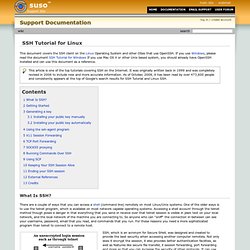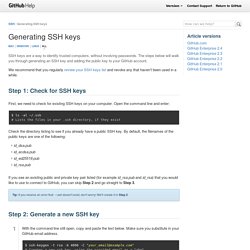

Apprendre à utiliser les listes de compréhension en python, cours pour débutants. L'homme augmenté. Question about bcast and ucast. Installer un réseau Wi-Fi sur Ubuntu et dérivés - Linux. SSH keys Permission denied (publickey,gssapi-keyex,gssapi-with-mic) SSH Tutorial for Linux - Support Documentation. This document covers the SSH client on the Linux Operating System and other OSes that use OpenSSH.

If you use Windows, please read the document SSH Tutorial for Windows If you use Mac OS X or other Unix based system, you should already have OpenSSH installed and can use this document as a reference. This article is one of the top tutorials covering SSH on the Internet. It was originally written back in 1999 and was completely revised in 2006 to include new and more accurate information. As of October, 2008, it has been read by over 473,600 people and consistently appears at the top of Google's search results for SSH Tutorial and Linux SSH.
What Is SSH? There are a couple of ways that you can access a shell (command line) remotely on most Linux/Unix systems. An unencrypted telnet session SSH, which is an acronym for Secure SHell, was designed and created to provide the best security when accessing another computer remotely. Generating SSH Keys. SSH keys are a way to identify trusted computers, without involving passwords.

The steps below will walk you through generating an SSH key and adding the public key to your GitHub account. We recommend that you regularly review your SSH keys list and revoke any that haven't been used in a while. Tip: GitHub has a desktop client! You can use it without ever touching the command line. Tip: If you have GitHub for Windows installed, you can use it to clone repositories and not deal with SSH keys. Step 1: Check for SSH keys First, we need to check for existing SSH keys on your computer. Ls -al ~/.ssh# Lists the files in your .ssh directory, if they exist Check the directory listing to see if you already have a public SSH key. Passwordless SSH. Passwordless SSH can be accomplished using SSH's public key authentication.

To configure passwordless SSH, follow the directions below. Warning: passwordless SSH will make your systems less secure. If you are comfortable with that, the directions below will walk you through server and client configurations. Then, I'll show you how to debug SSH if you encounter problems. SSHD Server Configuration First, you must ensure that your SSHD server allows for passwordless authentication using public keys. If you have root privileges, edit your system's /etc/ssh/sshd_config and apply the following settings. . # Disable protocol 1 RSA key based authentication RSAAuthentication no # Protocol 2 public key based authentication PubkeyAuthentication yes # Authorized public keys file AuthorizedKeysFile .ssh/authorized_keys If you make any changes, save them and restart your SSH server. service sshd restart.
Can't get SSH keys (DSA) to work [FIXED] (Page 1) / Networking, Server, and Protection. Getting started with SSH - Kimmo Suominen. The following sections hope to provide enough information to setup a user new to ssh with the appropriate files necessary for accessing remote hosts in a secure manner.

Improvements to and comments about this document are welcome. Updated: The examples now show ssh version 2 commands, using OpenSSH. There are several security vulnerabilities in protocol version 1. Everyone should have already migrated to version 2 by now, so it was about time for me to also reflect best practises in this document. I also updated the link section at the end of the document to better reflect today’s software selection. Contents About public key cryptography Public key cryptography uses a public key to encrypt data and a private key to decrypt it. What this means is that it is safe to send your public key (i.e. the contents of the ~/.ssh/id_rsa.pub file) in electronic mail or by other means e.g. to have a system administrator of a remote site install that key into your ~/.ssh/authorized_keys file.
. #! ?